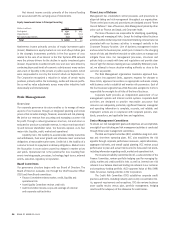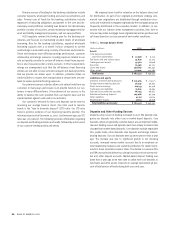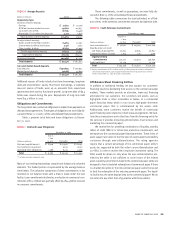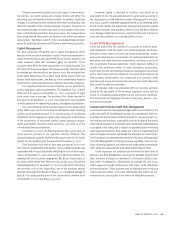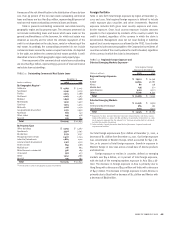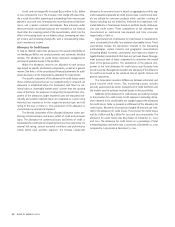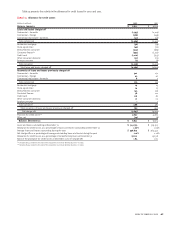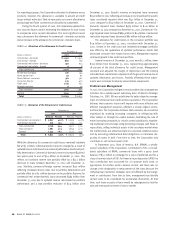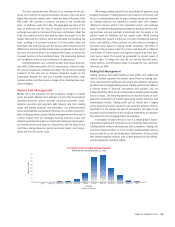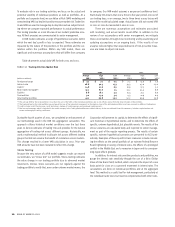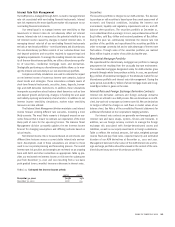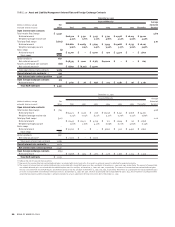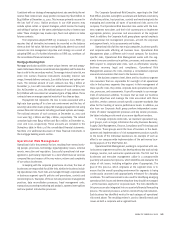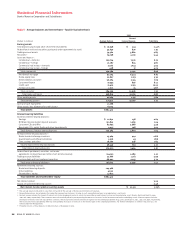Bank of America 2002 Annual Report Download - page 48
Download and view the complete annual report
Please find page 48 of the 2002 Bank of America annual report below. You can navigate through the pages in the report by either clicking on the pages listed below, or by using the keyword search tool below to find specific information within the annual report.
46 BANK OF AMERICA 2002
Credit card net charge-offs increased $422 million to $1.1 billion
in 2002 compared to 2001. The increase in net charge-offs was prima-
rily a result of portfolio seasoning of outstandings from new account
growth in 2000 and 2001, new advances on previously securitized bal-
ances, and a weaker economic environment. New advances under
these previously securitized balances are recorded on our balance
sheet after the revolving period of the securitization, which has the
effect of increasing loans on our balance sheet, increasing net inter-
est income and increasing charge-offs, with a corresponding reduc-
tion in noninterest income.
Allowance for Credit Losses
To help us identify credit risks and assess the overall collectibility of
our lending portfolios, we conduct periodic and systematic detailed
reviews. The allowance for credit losses represents management’s
estimate of probable losses in the portfolio.
Within the allowance, reserves are allocated to each product
type based on specific and formula components, as well as a general
reserve. See Note 1 of the consolidated financial statements for addi-
tional discussion on the Corporation’s allowance for credit losses.
The specific component of the allowance for credit losses covers
those commercial loans that are our nonperforming or impaired. An
allowance is established when the discounted cash flows (or col-
lateral value or observable market price) is lower than the carrying
value of that loan. For purposes of computing the specific loss com-
ponent of the allowance, larger impaired loans are evaluated indi-
vidually and smaller impaired loans are evaluated as a pool using
historical loss experience for the respective product type and risk
rating of the loan. In Table 17, this component of the allowance is
characterized as commercial impaired.
The formula component of the allocated allowance covers per-
forming commercial loans and leases, letters of credit and consumer
loans. The allowance for commercial loans and letters of credit is
established by credit type by analyzing historical loss experience,
by
internal risk rating, current economic conditions and performance
trends within each portfolio segment. The formula component
allowance for consumer loans is based on aggregated portfolio seg-
ment evaluations generally by credit product type. Loss forecast mod-
els are utilized for consumer products which consider a variety of
factors including, but not limited to, historical loss experience, esti-
mated defaults or foreclosures based on portfolio trends, delinquen-
cies and credit scores. These components of the allowance are
characterized as commercial non-impaired and total consumer,
respectively, in Table 17.
A general portion of allowance for credit losses is maintained to
cover uncertainties that affect our estimate of probable losses. These
uncertainties include the imprecision inherent in the forecasting
methodologies, certain industry and geographic concentrations
(including global economic uncertainty) and exposures related to
legally binding commitments that have not yet been drawn. Manage-
ment assesses each of these components to determine the overall
level of the general portion. The relationship of the general com-
ponent to the total allowance for credit losses may fluctuate from
period to period. Management evaluates the adequacy of the allowance
for credit losses based on the combined total of specific, formula and
general components.
The Corporation monitors differences between estimated and
actual incurred credit losses. This monitoring process includes
periodic assessments by senior management of credit portfolios and
the models used to estimate incurred losses in those portfolios.
Additions to the allowance for credit losses are made by charges
to the provision for credit losses. Credit exposures (excluding deriva-
tives) deemed to be uncollectible are charged against the allowance
for credit losses. Table 15 presents a rollforward of the allowance for
credit losses. Recoveries of previously charged off amounts are cred-
ited to the allowance for credit losses. The provision for credit losses
was $3.7 billion and $4.3 billion for 2002 and 2001, respectively. The
allowance for credit losses was $6.9 billion at December 31, 2002
and 2001. The allowance for credit losses as a percentage of total
outstanding loans and leases was 2.00 percent at December 31, 2002
compared to 2.09 percent at December 31, 2001.


